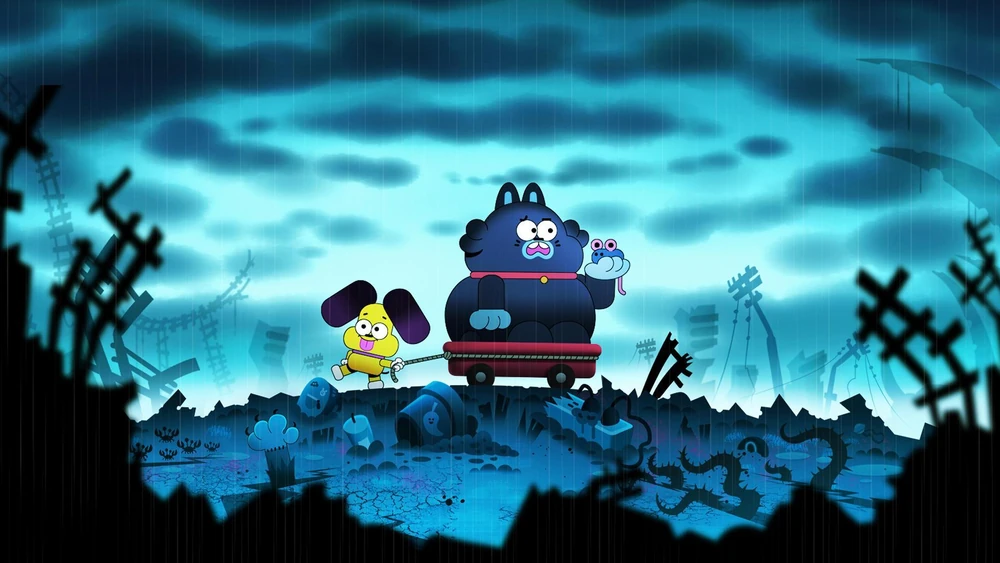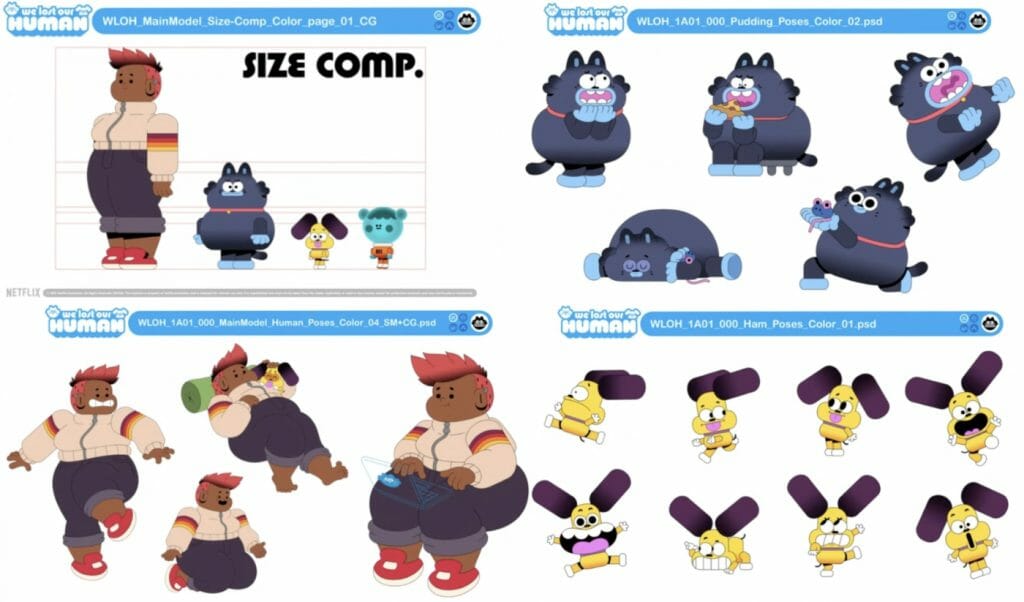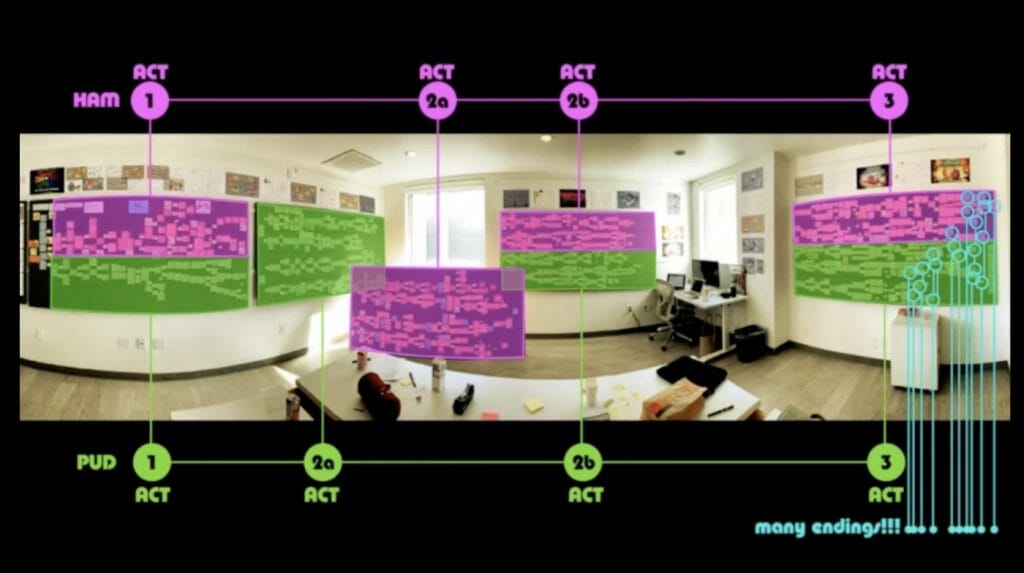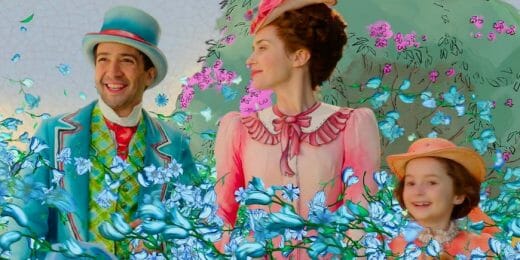
Rikke Asbjoern and Chris Garbutt are the co-creators of Pinky Malinky as well as the Netflix interactive special, We Lost Our Human. The show features a self-involved cat (Pud) and a hyperactive dog (Ham), who wake up one day to find that all humans, including their human, have mysteriously disappeared from earth. As an interactive special, viewers can guide Pud and Ham through multiple paths in the story.
We invited Rikke and Chris onto our livestream in December 2022 to discuss their experience developing an interactive animated film. The creative duo are artists who have extensive experience writing and directing for children’s television, and this excerpt from our live interview covers their journey from pitching and planning an interactive animated special, to troubleshooting challenges along the way, as well as their advice for artists interested in working on interactive animated specials.
As you’re going through We Lost Our Human and looking at previous interactive specials at Netflix, did you have people or resources that you could talk to who had gone through the process before you?
Rikke: We had quite a few people that we talked to in the beginning. We tried to talk to anyone who had any experience, because we wanted to avoid as many mistakes along the way as possible. We had to build this whole pipeline for an interactive experience at a size that no one had attempted before.
So we met up with people from Bandersnatch and a lot of other smaller animated specials. We were just trying to get the lowdown on anything and everything that could go wrong along the way. I mean, obviously, there would be things because the scale [of interactive video] that we’re attempting hasn’t been tried before in animation.
Chris: We definitely had a lot of great support from Netflix in that regard. Our immediate executive on this project, Julius Harper Jr., had a lot of experience with interactive projects. So he was super, super helpful in getting us set up and guiding us along the way. We had our branching narrative consultants, we had two that were brought in from outside the studio. And the whole team at Los Gatos were fantastically supportive throughout the entire process.
Rikke: They have done all the stuff that came before. So they shared all of their experiences. It was also interesting to work on something where the tech side evolved as we were doing it. So something that was impossible in the beginning became possible half a year later, which was exciting. Because all of a sudden, things were a bit faster, ran smoother. We could do things that we would be dreaming about in the beginning, but we didn’t know if it was actually possible.
Can you tell us a little bit about We Lost Our Human’s animation style and some of the animation techniques used on the special?
Chris: Sure. It was animated in Toon Boom Harmony by Jam Filled. We had used Harmony before on Pinky Malinky and again with Jam Filled. So it was a software that we were aware of how to work with, certainly in regards to animation and design. And you’re trying to get the characters built and designed in a way that would make sense for that particular software.
And like on Pinky, we used After Effects for compositing. We had quite a heavy compositing pass on this to try and get the characters two dimensional, although there’s some shading on there to give them a bit more volume. For the backgrounds and environments we’ve really pushed depth of field. We’re doing a lot of stuff with the compositing to try and create that depth, just to make it feel more cinematic, more epic, and have those characters really pop.
Rikke: The animation style definitely has similarities to Pinky with that snappy feel. But this is probably the 2.0 version of it. We’re working within the budget, but we’re still trying to really push it. How can we get this a little more feature-like? It still has that snappy animation that we both really like. And it just suits the design and suits the program we were making. Like, spending more time on the acting. the facial expressions and like less floaty movements of the body.
Chris: This is more cinematic. Pinky Malinky was more of a sitcom-style, it had that mockumentary/reality show element. So it was a bit more cartoony and poppy. With this one, although it still has that quality to the animation, we wanted it to feel more epic, and more cinematic, which goes across animation and design. Jam Filled did a fantastic job.

When you have simpler characters with very geometric, stylized designs, does it make it easier to focus on the animation and acting?
Chris: Yeah, definitely. There are many things you have to take into consideration. One of them is just pure storytelling. You want the characters to be clearly communicating emotions and acting, with nothing cluttering that up.
And then you have to take the practical considerations as well, like production costs. If it is an incredibly complex character, it’s going to take a lot longer to not only animate, but to build as well.
Rikke: If you don’t have the budget to do it justice, you should rethink what that design looks like.
Chris: It’s a balance as well, because sometimes you want subtlety in the acting. Sometimes, if you have a very simple-looking character, you can lose some of that subtlety. So it’s knowing when to bring in that extra detail, like the extra little line around the eye or whatever, which is just going to help sell a particular expression. Balancing that in there so it feels still in style, and it doesn’t suddenly pop in,, unless that’s obviously the point of that pose or whatever.
How did the project come about? And what was it like to pitch We Lost Our Human?
Rikke: It was at the best possible time, really. We were lucky that we were pitching right when Netflix was buying a lot of interesting, funny projects. A lot of it was timing, which is always what it is.
Chris: Within that first year of the Netflix Animation really getting off the ground, they were actively looking for a lot of very different interesting projects. We knew a few people that were over there who we worked with in the past at Nickelodeon. And we were aware that they were also looking for interactive stuff.
Rikke: But the two interactives we pitched weren’t actually in our pitch deck until maybe four days before we went in there. Because that’s when we were told that they were actively looking for that. We had already had the idea, but we weren’t sure if we should put it in there.
Chris: I would like to contrast that with Pinky Malinky, just so people know that it doesn’t come that easily. We first started working on Pinky in 2005 and that didn’t get greenlit until 2015. We’ve been through the hard stuff as well. This one flowed a little bit easier.
Rikke: It was a lucky time for us and a lot of other people who got the opportunity to make their dream projects. All of us who got to be part of that studio at that time are grateful for that.

As artists with experience in television animation, how was the experience of working on an interactive special different?
Chris: There’s quite a few different things. You have to approach it differently. And a lot of it we discovered as we were going along, which was kind of scary, but fun at the same time.
For example, storyboarding and animatics. This is kind of built-up of lots of different segments, because it’s interactive. You’re building up all of the segments that connect in different ways, depending on which paths you’re doing. If you’ve seen one storyboard sequence that finishes with a choice point that can go many different directions, you have to make sure that all of those segments work together. As well as follow the narrative flow.
You have to check that during the storyboard phase, but you also have to be able to check the animatic. So it just made it very time-consuming. It took a lot longer than we thought it would.
Rikke: We thought we had been quite conservative, giving ourselves quite a lot of time to do that. In the whole production, that was what we underestimated the most. How long that would take, to do all of that checking.
Chris: And it’s not because anyone was doing anything wrong.
Rikke: There’s no shortcut. You have to sit through it. You have to watch it. It’s just hours in front of the screen that you can’t skip.
Does the process of making sure that the character poses ‘hook up’ from one scene to the next get more complicated when there are branching scenes?
Rikke: Definitely. And also just going from a mid-shot to a mid-shot.
Chris: Not only do you sometimes have a singular path that branches out into many different directions, sometimes it works the other way where you’re coming from lots of different directions into one path. So you’re checking packets going out, checking packets going in. There’s a lot of checking all the way across.
Something which is really fun in these projects is you can introduce state tracks and elements. For example, if you’re given a choice to pick up a certain item, then that is tracked. So when you’re further down the story, it will acknowledge that you’ve made a choice to pick up this item. So there’s lots of elements like that, whether it’s a piece of clothing that they’re wearing, or the character said something, or an item, or whatever it is. That’s when it really explodes.
Rikke: It’s really satisfying to do. But that’s when it really adds hours for the animatic reviews.

What appealed to you about the interactive format? Was it the challenge involved?
Rikke: I always loved those books. So it’s really cool to get the chance to do that.
Chris: We’ve both been into those Fighting Fantasy and Choose Your Own Adventure books, we’ve both played Dungeons & Dragons when we were younger and video games as well. So there’s always been that element of interactivity in a lot of media that we’ve kind of grown up using. And to be honest, Choose Your Own Adventure stuff is something that’s always been in people’s minds, it’s just the technology has never been there.
So conceptually, the interactive format in animation is not that new. It’s just that now the technology is actually there to make it happen. That’s why the heroes of this whole thing are the tech people at Netflix, who really nailed this down, made it work and gave us a platform to actually do this.
Was the process of naming these characters challenging? Pudding and Ham both have food names, which is always amusing for pets.
Rikke: We always tend to go for silly names.
Chris: When you’re creating or writing anything, there is a process of trying things out, maybe seeing what sticks and what suits the character. And the more you get to know the character, you figure out what actually works for them.
You mentioned that you had a chance to do some hands-on work on this project in addition to producing and writing. What were some of the favourite moments on the production side?
Rikke: We were involved in everything.
Chris: Yeah, we were directing the whole thing. So we were connected to every single part of the process. Making something like this, whether it’s interactive or veneer, is always super fun because of the crew that you get to work with.
All across writing, storyboard design, animatics, working with all of these fantastically talented people to get them to kind of get involved, bring their own voice, bring their talent to the project, and plus it in a way that you can be measured, that’s so rewarding. Getting to build that team and receive the kind of results.
Rikke: The first board pitches are always so exciting – when everything starts turning into something that you can actually see. Because you’ve had the writing for so long. When you start seeing these pictures, it’s like, “Oh, yeah, this is what the apartment looks like. This is what they look like. This is what they feel like when they’re moving around.” That’s always super fun.
Chris: And, I mean, we are control freaks for a lot of stuff that we do. So we can’t help but get stuck into things like storyboarding as well. And I was art directing, so I was obviously involved in some of the design stuff. And we were both doing design work at the conceptual stage as well. Again, we have such a fantastic team, so thankfully we could allow people to just go off and do their own stuff.
Rikke: They came up with so much incredible stuff. And that’s really what it’s all about: getting everyone to pitch in and getting all these talented people together. We all build it together. It’s up to us to connect the dots.
Chris: The other elements that are always super exciting are when you’re building the cast. For example, with Pudding the cat. We knew exactly what we wanted for that from day one. We wrote that character for Ben Schwartz, because we’d worked with him before on Pinky Malinky. And then we were like, “Oh, I hope we get him, because if we don’t we’re kind of screwed.” Thankfully, Rikke bumped into him in a cafe.
Rikke: By accident! And I was like, “Do you want to come into Netflix and see what we’re doing?”
He came in and we basically pitched him. We showed him the room we showed you before, allowed him to make the choices along the way. So we let him play the experience. He thought it was really cool. He really loves animations, and games.
Chris: Thankfully he came on board, which was fantastic. Then we had Ayo Edebiri, who played Ham, and she’s a great comedian.
Do you have advice for other artists who are interested in interactive animation?
Rikke: If you’re going to attempt to write an interactive story, my one bit of advice that we have learned from doing this is put it up on a wall so you can see it. That was one thing that really worked out well. Don’t put it in the computer too soon, where you lose the overview. Literally put it up on the wall and connect everything. That’s a really good way to check it.
Chris: Some advice for artists that are just getting into the industry and are interested in interactive things: I wouldn’t just look at that. I think it’s great if you want to do that, but make sure that you have the skillset to also be working in linear format.
The more that you can spread your skillset across regular animation, video games, interactive, even illustration, the more likely you are to stay in work. The industry has different cycles of being busy to work being hard to find. The more that you can be versatile, the better off you will be.
- Interested in seeing more from Rikke and Chris? Be sure to play We Lost Our Human on Netflix and follow Rikke (@fattywhale) and Chris (@thatdamngarbutt) on Instagram.
- Ready to start animating scenes for your next interactive animated project? Artists can download a 21-day trial of Toon Boom Harmony Premium.



